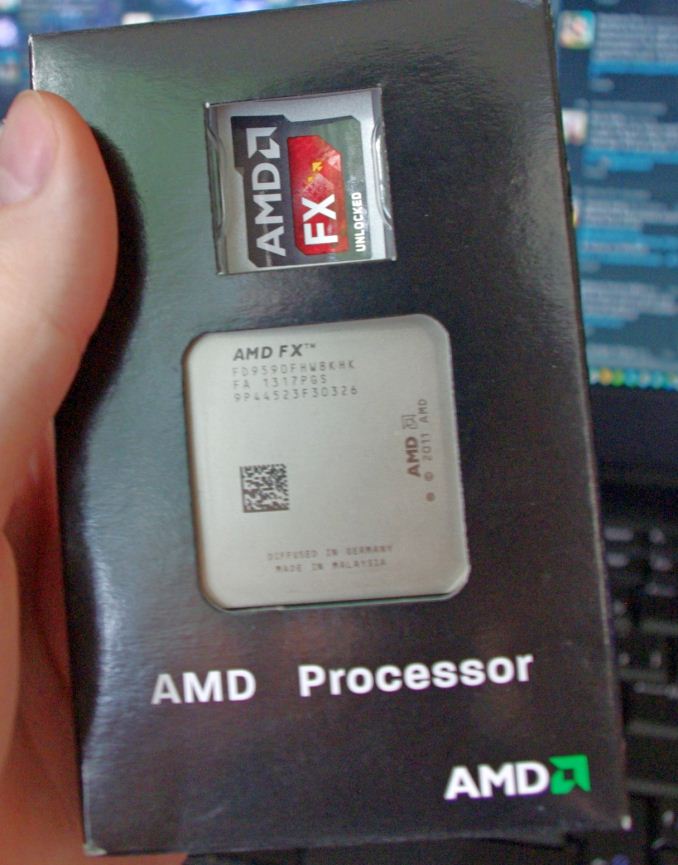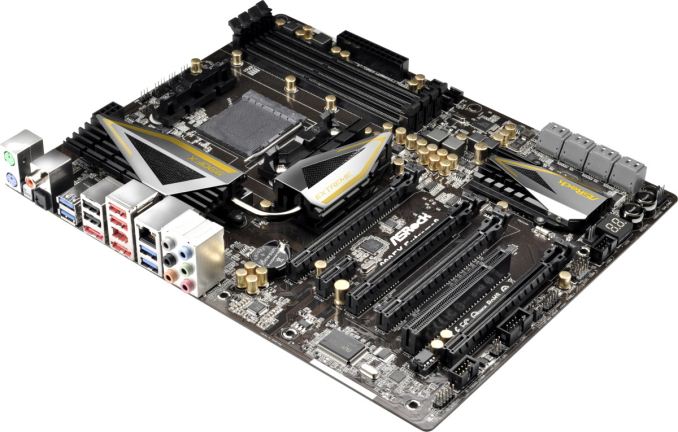AMD’s 5 GHz Turbo CPU in Retail: The FX-9590 and ASRock 990FX Extreme9 Review
by Ian Cutress on August 9, 2014 8:00 AM ESTThe AMD FX-9590
The analysis in this review shows that even a year after the OEM release of the FX-9590, and almost two years from the architecture coming to market it remains AMD’s performance part. If power consumption is not a concern, as a CPU compute and an AMD gaming CPU (especially when considering SLI) the FX-9590 is the best choice at stock speeds. On that basis alone, it makes sense that AMD should actually release it as a retail part, assuming they have enough stock. One might argue that a user could buy an FX-8350 and overclock, but if our sample CPUs were anything to go by, a user needs a fair bit of luck. The FX-9590 guarantees a 5.0 GHz turbo with a warranty.
With the retail release of the CPU, that warranty might be based on using the water cooling provided for the lifetime of the CPU. One might argue that AMD had trouble finding enough dies that could reach the frequencies and voltages for the FX-9590, and hence the delay combined with selling the SKU in select markets only.
The FX-9590 is the same Piledriver architecture as the FX-8350, which in turn was used in the A10-5800K/A10-6800K APUs, codename ‘Trinity’ and ‘Richland’ respectively. Since then, AMD has launched the Steamroller architecture modifications in the form of Kaveri APUs. The difference between a PIledriver APU and a similar frequency Steamroller APU, if we put aside the move from 32nm SOI to 28nm SHP, is around 10% for CPU performance. If that was shifted into a four-module, eight-thread CPU, it would surely be AMD’s performance part. The issue here is that AMD has almost discarded the high CPU performance arena in favor of integrated graphics. From Trinity to Kaveri, the IGP inside those APUs has improved considerably, indicating where AMD is investing its research dollars.
AMD clearly still cares about the performance market, otherwise this retail FX-9590 with water cooling would have never been pushed through to retailers. The high power consumption, the lack of a modern chipset, and the comparison to Intel CPUs in single threaded benchmarks are the main barriers to adoption. If AMD is to return to the performance market, the power consumption has to be comparable to Intel, or if it is slightly higher, the chipset has to offer something Intel cannot. Any suggestions for what that feature should be should be submitted on a postcard/in the comments.
ASRock 990FX Extreme9 Conclusion
One of the big issues surrounding AMD motherboards is their price sensitive nature. With an Intel based product, a $250-$400 motherboard is common enough to signify the expense in research or extra features. Because the AMD ecosystem, even in the high performance segment, is a cost sensitive market there is little room to move. For example, this year sees the first overclocking based motherboard for AMD APUs since the AM3+ era. So at $170, the Extreme9 could arguably be described as ‘limited’ compared to Intel standards.
The motherboard itself has specified support for 220W CPUs, something other motherboards either fail to mention or advise against completely. The native SATA 6 Gbps ports were ahead of Intel at the time, plus ASRock adds in another SATA 6 Gbps controller for good measure.
The eight USB 3.0 ports makes the Extreme9 have more USB 3.0 ports than almost every other 990FX/AM3+ motherboard ever released. This is combined with plenty of legacy support, such as separate PS/2 connectors, a PCI slot, an IEEE1394 port and an IEEE1394 header. The Intel NIC is paired with a Realtek ALC898 codec, with the PCIe layout aimed at 3-way GPU users for both Crossfire and SLI.
Aside from an updated chipset, if we were building a high-end AM3+ motherboard in 2014, I would insist on WiFi support and an upgraded audio codec to the ALC1150 at the minimum. We cannot get around the lack of PCIe 3.0 support, although moving the CPU modules from Piledriver to Steamroller along with the IO support might help with that. If we are being greedy with what we would like, I would add in M.2 support as well.
There is plenty to speculate if AMD had kept updating their high-end performance CPU line, even if the socket was not updated. As it stands, users who want SLI either look back to 990FX or invest in Intel. Users who want high multithreaded CPU performance either look back to 990FX or invest in Intel. Users who do not want processor graphics either look back to 990FX, buy an APU with the graphics disabled, or invest in Intel. AMD clearly does care about the performance market, or at least someone senior in the company does.












146 Comments
View All Comments
BMAN61 - Sunday, August 10, 2014 - link
" Alongside testing this CPU, the 220W TDP requires a substantial motherboard to match. Due to the age of the platform, the AM3+ socket and the old 990FX chipset, finding a motherboard can be rather tricky. Many of the AM3+ motherboards that were launched were only suited for the FX-8350 processors, which had a 125W TDP. This is yet another reason that AMD wanted the FX-9590 in the hands of system builders who would chose high end motherboards that could cope.Two of the newest motherboards to be released for 990FX were the ASRock 990FX Killer and the ASRock 990FX Extreme9. We reported the release of the Killer in December 2013, but the Killer is unsuitable here as the specification sheet lists processors up to 125W only. The Extreme9 is ASRock’s high-end AM3+ motherboard, and more suited to the task. "
This statement isn't entirely true; the ASUS Sabertooth 990FX motherboard supports this 220 watt CPU http://www.asus.com/ca-en/Motherboards/SABERTOOTH_... the only requirement is a BIOS update and better cooling.
StrangerGuy - Sunday, August 10, 2014 - link
So ~$170 solely for a mobo to reliably run a AMD chip.Intel is laughing to death somewhere a 4790K can be dropped into the cheapest of S1150 mobos and it just simply works.
just4U - Sunday, August 10, 2014 - link
Off the top of my head I don't know of anyone who has purchased a $350 i7 and paired it up with a $65 motherboard.. Most won't even use the stock cooler since +80c temperatures under load is a little on the alarming side.. Those that tend to purchase it as part of a new system are usually looking at $170 Motherboards and $30+ coolers.StrangerGuy - Sunday, August 10, 2014 - link
Intel temperature issues != AMD power delivery issues. The former can simply be solved with a $30 HSF, while the latter needs a $170 mobo AND even stronger cooling.And I'm one of those guys who run a 4790K on a $60 budget mobo. Paying an extra $100 for CPU at 4GHz stock with even higher turbo and HT is certainly more value for money than a $240 4690K with a $160 mobo with extravenous features that I don't need, and this does not include extra costs for cooling a OCed chip plus dealing with chip lottery. I don't know why is that even surprising to some...
just4U - Monday, August 11, 2014 - link
I don't believe you have a $60 board paired up with your 4790K. Sorry S... it simply doesn't make sense. You may not have Z97 deluxe but I think it's doubtful you've paired it with a H81 either.. That's like going out and buying a 780Ti and then using the worst turd of a PSU to power the damn thing.. or saying yeah this Celeron should be enough for that.. lol.. no.designgears - Sunday, August 10, 2014 - link
*facepalm*How many time did a stock i5 just beat an 8 core OC chip?!
mapesdhs - Tuesday, August 12, 2014 - link
A point which way too many AMD fans simply choose to ignore. Ah the 1st Rulestrikes again...
Ian.
nenforcer - Sunday, August 10, 2014 - link
The Realmark Audio Analyzer results have labeled this motherboard as having the Realtek ALC1150 audio codec just like most other modern motherboards, however, as stated previously in the article this motherboard has the older Realtek ALC898 codec.Jedibeeftrix - Sunday, August 10, 2014 - link
"If AMD is to return to the performance market, the power consumption has to be comparable to Intel, or if it is slightly higher, the chipset has to offer something Intel cannot. Any suggestions for what that feature should be should be submitted on a postcard/in the comments."24 PCIe 3.0 lanes on-die for uncompromised graphics whilst allowing M.2/Express at 3.0 4x:
http://jedibeeftrix.wordpress.com/2014/07/25/amd-t...
silverblue - Sunday, August 10, 2014 - link
Kaveri, from a technological standpoint, is a refined version of Zambezi, but it's still not perfect; they fixed an AVX bug but hamstrung FP adds somehow. Work done per module is improved due to the decoder changes.We don't know how L3 cache would help performance, as this is the first edition of the architecture that doesn't have such a flavour. The other issue is the reduced clock speed thanks to the 28nm SHP node; while it's very possible that a 4M/8T setup would exceed the 8350's performance, how much power would it use for that? I would theorise such a CPU (note - same clocks as the 7850K, and without L3 cache) outperforming the 8350 by about 10-15% in MT workloads, matching it in ST and even falling behind by 10-15% in FP; perhaps that's another reason for the lack of an FX line given that it'd be a regression. Right now, I don't think it'd serve in AMD's best interests to release a new FX series as it wouldn't benefit consumers at all.
I should imagine that if Excavator brings the rumoured IPC gains, AMD would simply dump AM3+ and resurrect FX as a 2M/4T FM2+ part; in essence, an i5 competitor. They did say that improved IPC was Excavator's raison d'etre; considering MT is fixed, it should mean instructions per core. Get the IPC high enough and they won't NEED to clock the parts so high, thus lower power; on this point, Carrizo is supposed to be rated at 65W TDP.